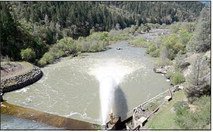Ukiah Daily Journal
By Justine Frederiksen
udjjf@ukiahdj.com
The Pacific Gas and Electric Company announced this week that while it plans to restore the hydroelectric plant in Mendocino County called the Potter Valley Project to working order, the repairs could take years to complete.
“During a routine inspection in July of 2021, PG&E discovered a transformer at its Potter Valley powerhouse that did not meet our operating standards (and) the powerhouse has been offline since that time,” states an email the agency sent to stakeholders announcing that the problem would be rectified. “PG&E has completed its evaluation of whether to replace the transformer and concluded it is beneficial to PG&E’s electric generation customers to proceed with the work necessary to return the powerhouse to full operational status.”
As to when those repairs might be completed, the agency explains that “our experience with this kind of work indicates the repairs could be completed in the next couple of years, but we will not know until the detailed engineering is completed later this year.”
Since the hydroelectric plant diverts water from the Eel River in order to conduct electricity, the amount of water that usually flows from the project into the Russian River and Lake Mendocino has been significantly reduced for the past several months.
Several of the water agencies in Mendocino County, as well as the Sonoma County Water Agency and the city of Ukiah, sent letters to PG&E late last year requesting that it divert more water “up to the capacity of the powerplant bypass system, approximately 140 cubic feet per second, (which) will help meet critical water needs in the face of extreme drought conditions.”
When asked Wednesday if the bypass system would be used to increase diversions from the Eel River into the Russian River, PG&E spokesman Paul Moreno said that the agency “feels strongly that the Russian and Eel River interests need to collaborate and deliver a joint request to PG&E for such diversions” since they would have impacts on both watersheds.
“Because PG&E cannot use the annual discretionary diversions for electric generation while the powerhouse is offline, it is inappropriate for PG&E to unilaterally decide and make the diversions requested by SCWA and IWPC,” Moreno wrote, referring to the Sonoma County Water Agency and the Inland Water and Power Commission of Mendocino County, which both requested that the bypass system be used to divert more water, along with the Potter Valley Irrigation District, the Redwood Valley Water District, the Millview, Willow, Calpella and Hopland water districts, as well as the Mendocino County Farm Bureau, the Mendocino County Water Agency and the Russian River Flood Control and Water Conservation Improvement District, and the city of Ukiah.
“PG&E has continued to express its full willingness to explore the possibility of making discretionary diversions but feels strongly that the Russian and Eel River interests need to collaborate and deliver a joint request to PG&E for such diversions.
“We understand and empathize with the wants, needs, and valid concerns expressed by stakeholders from both the Russian and Eel watersheds,” Moreno continued. “(And) although we understand consensus may be difficult, we maintain it is critically important for the key watershed stakeholders in both basins to engage in meaningful dialogue on this issue to establish whether a mutually acceptable path forward, consistent with existing license requirements, can be recommended to PG&E.”
Moreno described the amount of water that Lake Mendocino receives from the Potter Valley project as “on average, less than 30 percent (about 70,000 of the 235,000 acre-feet) of the annual inflow to Lake Mendocino.
The Potter Valley Project FERC license requires PG&E to deliver approximately 58,000 acre-feet of water to the East Branch Russian River in a normal water year, and approximately 45,000 acrefeet in a dry water year (i.e., the “obligation” water), which will continue consistent with license requirements.
“Since 2007, PG&E has also diverted an annual average of approximately 12,000 acre-feet of ‘discretionary’ water for electric generation to the East Branch Russian River during December through March when conditions (at Lake Pillsbury) allow,” Moreno continued. “This discretionary diversion represents about 17 percent of PG&E’s average annual diversion to the East Branch Russian River, about 5 percent of the overall annual inflow to Lake Mendocino, and about 0.2 percent of the annual flow of the Eel River during that period.”
Also this week, a regional coalition of representatives from Mendocino, Sonoma and Humboldt counties that was preparing to take over operations of the hydroelectric plant announced it is halting its effort to renew the license for the project that PG&E still owns, but has decided not to relicense.
Janet Pauli of the IWPC, which joined with the Sonoma County Water Agency, California Trout, Inc., the County of Humboldt, and the Round Valley Indian Tribes to form the Two-Basin Partnership in 2019, said Wednesday that the coalition did “not come close” to raising the $11- to $15 million required to file for re-licensing, and therefore it reported to FERC that it would be unable to file a license application by the April 14, 2022, deadline.
The Two-Basin Partnership had previously asked FERC to give them until May 22 to file an application, but the request was denied.
In its request, the partnership stated that “in January of 2019, PG&E stated its intent not to seek a new license (for the plant.) That June, parties filed a Notice of Intent and began to pursue relicensing of the plant to implement a Two-Basin Solution. Since that time, the NOI Parties have not been able to secure the funds to undertake studies per the Study Plan Determination, at estimated cost of $18 million for two years. In May, PG&E declined to fund such work.”
Pauli said Wednesday that the future of the Potter Valley Project is very much uncertain, and only “time will tell” whether the coalition’s effort to take over the project can be revived.

